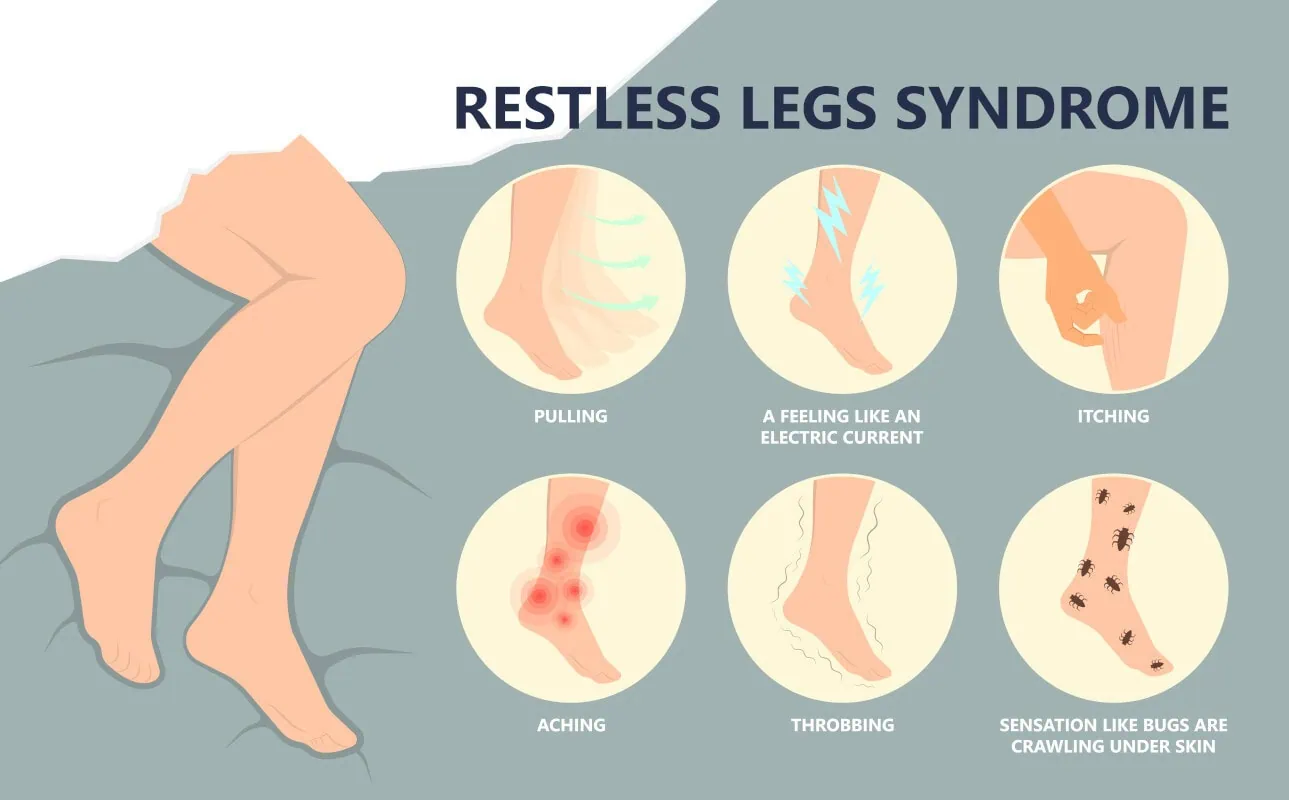
What Is Restless Leg Syndrome?
Restless legs is thought to affect approximately 10% of the population. Perhaps half of those people may be having mild symptoms, but the other half may be having severe symptoms. Sadly, restless legs is a problem that primary presents itself at night as many people can function fine during the day. Once one goes to bed, the symptoms may start. While the rest of us are sound asleep, their sleep is interrupted and for many, the amount of sleep they get is severely limited. Another name for restless legs is Willis Ekbom disease.
Restless Legs Causes and Symptoms
Restless leg syndrome sensations
Most will agree that one of the most common symptoms of restless leg syndrome, RLS, is anxiousness. Some will call it nervous legs. Once a patient with restless legs goes to bed or sits down, their feet and legs may start to feel anxious and have the irresistible urge to move your legs to alleviate the symptoms. In bed at night, many patients have to get up and walk around multiple times. Other symptoms may include twitching that can happen involuntarily, and others may have creepy crawly sensations and cramping. When the jerking is severe, it is referred to as “periodic limb movement disorder” or also called periodic limb movement of sleep.
What are Thought to be The Causes Of Restless Legs
Drugs to treat restless legs:
Conventional medicine has some studies that would point to a lack of dopamine in the brain as being a risk factor for restless legs. Dopamine is a neurotransmitter and because of these studies, conventional medicine suggests increasing dopamine levels may provide relief. Therefore, medications that increase dopamine levels are prescribed. The medicines that increase dopamine levels are ropinirole and Mirapex. Taking these medications may have significant side effects for patients and once you start taking these medications, and with worsening symptoms, the doses might be increased, and you may go through a process called augmentation.
Augmentation happens when you reach a maximum dose as the symptoms of restless legs continue to worsen. There can also be severe withdrawal symptoms from these medications. These medications have also been shown to cause addictive disorders such as addiction to vices such as gambling and sex . Other medications that are recommended include gabapentin and Lyrica. These drugs are frequently recommended in the treatment of neuropathy. Some of their side effects include fogginess and weight gain from taking Lyrica . Low iron levels or iron deficiency may impact restless legs and there are some patients who are suggested to take iron supplements as treatments to increase iron levels. However, some doctors who specialize in sleep medicine may suggest doing sleep studies where patients are observed in a lab to see how much of their sleep is disrupted.
Restless Legs Syndrome Treatment
Non-drug treatments:
Other than the use of pharmaceuticals, the following may be helpful especially when the symptoms are mild:
- Massage the legs before bed
- Take a warm bath or use heating pads
- Exercise regularly
- Avoid caffeine, alcohol, and nicotine
How is Restless Legs Diagnosed?
Restless legs is unusual that the diagnosis is made by the patient’s symptoms. There are no definitive tests that are used to diagnose restless legs.
Refractory Restless Legs Syndrome
For many, medications may be helpful but there are patients that have refractory RLS which means they do not respond to any medications that they are given.
Risk factors:
- Diabetes – this medical condition can increase the likelihood of having restless legs symptoms.
- Genetics – many studies claim that many people with restless legs have somebody else in the family who also has restless legs.
- Gender – restless legs occur twice as frequently in women than men
- Other health conditions – kidney disease, iron deficiency, and pregnancy may also be associated with restless legs.
Why You Should Challenge Conventional Medicine’s Claim That There is No Known Cause or Treatment That Can Reverse Restless Legs?
For over a decade, we have had success reversing restless legs by opening the nerve pathways in the lower extremity where nerve tunnels have become tight and are compressing on nerves. Today we have one peer-reviewed study to validate our outcomes, and another study has been submitted for publication.
If The Symptoms are in Your Legs, Why Can’t The Cause be in Your Legs?
Understand that conventional medicine has no interest in embracing the concept of evaluating the peripheral nervous system and finding the cause of restless legs there. They continue to promote drugs by selling Ropinirole, Mirapex, and other medications to the public through the doctors and medical research institutions that have been monetized to research more drug options. In recent years, the public has become more concerned about Big Pharma, and this is another area that you should have concerns about regarding restless legs. Consider this: if you are reading this blog and you see your doctor for restless legs, did you have a full neurological hands-on clinical examination of your legs? The answer is no. This in itself is evidence that doctors are not trained to consider the peripheral nervous system as a cause of your restless legs. The doctor will listen to your history, and based on your symptoms will give you the diagnosis of restless legs. They have not collaborated with your subjective complaints to a thorough examination of the health of the nerves in your legs.
The Story Behind The Discovery That Restless Legs is Reversible
My original training was with a professor of neurosurgery and plastic surgery at Johns Hopkins. His expertise was in upper extremities such as carpal tunnel surgeries. He took the principles of these concepts and applied them to the lower extremities, and I was one of the earliest doctors to start opening tight nerve tunnels in the lower extremities similar to carpal tunnel surgery, and have been able to reverse patient symptoms of patients suffering from neuropathy over 20 years. Over a decade ago, additional nerve tunnels in the legs were discovered and the tunnels were examined and were shown to be tight. We noted that by opening the tunnels we were having success not only reversing neuropathy but also restless leg symptoms. Gradually over time, we were showing that patients who have primarily restless leg symptoms with little neuropathy symptoms benefit from these restless legs syndrome treatment surgeries.
We perform restless legs syndrome treatment surgeries on a weekly basis, and many patients travel from throughout the United States and other countries to have a full neurologic evaluation and have the surgeries performed. I have also published a bestseller Amazon book called A Perfect Night’s Sleep. This book will give you more information regarding the pathway that led me to this discovery and also multiple patient stories along with research data to back up the success of these surgeries. Finally, we have one peer-reviewed, published study showing improvement of symptoms after nerve decompression surgery. Another study has been submitted for publication that measures nerve function before and after the nerve tunnels are open and demonstrates nerve function improvement. This proves objectively that nerve function is improved and correlates to the patient’s reversal of symptoms. You may also find other studies that have been published on our website and I have had the honor of receiving the Jules-Tinel Award for this body of research from my peers.
When to See A Doctor About Restless Legs Syndrome Treatment
When symptoms are mild, non-drug treatments may have some effects, however, when you start losing significant amount of sleep it may be time to consider consulting and doing conventional treatments with medications or consider the more modern approach to addressing the cause of the problem with nerve decompression surgery.
Serious RLS Should Not be Taken Lightly
The importance of a good night’s sleep to your physical and also mental health has become more apparent in research recently. There are studies that back up how a lack of sleep has a severe on men and women and can increase risk of early death. One study of 18,425 men found that men with RLS had 39% increased risk of death compared to men without RLS (source), and then for women it found that it was a 43% increased risk of dying from heart attack (source). Another study also found that RLS was associated with higher risk of suicide or self-harm (source).
Conclusion
Frequently Asked Questions (FAQs) About Restless Legs Syndrome Treatment
More evidence to back up that compression of nerve tunnels causes restless legs syndrome:
Q: Muscle weakness – Why do we frequently observe muscle weakness in the muscles of the foot and/or leg with patients with RLS?
A: damaged nerves are causing this weakness.
Q: Lack of sensation – Why can we demonstrate through our clinical assessment that people have less than optimal sensation in their feet?
A: damaged nerves are causing a reduction or abnormal sensation on the feet.
A: in the majority of cases, we observe compression on the nerve at the tunnels that are decompressed.
Q: Intraoperative nerve monitoring with EMG – Why is it that we have objective evidence during surgery that the nerves are working better after the nerve tunnels have been opened than before?
A: This supports that the nerve tunnels in the legs are too tight and are damaging the nerves.
Q: Recovery rate – How soon the patients experience relief?
A: This can happen within days. Follow the link to see an example as the operated leg from a week earlier is not jerking while the leg to be operated on is jerking immediately before surgery is performed.


